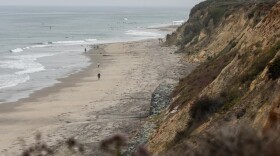A list of high ranking Navy officers are under scrutiny after two investigations revealed a series of mistakes led to the arson fire that destroyed the USS Bonhomme Richard in July 2020.
Two long-delayed reports outlined long-standing problems with how the Navy handles fires, dating back more than a decade. Adm. Bill Lescher, vice chief of Naval Operations, says the Bonhomme Richard could have been saved.
“I see the loss of Bonhomme Richard as preventable and wholly unacceptable,” said Lescher, during a call with reporters.
RELATED: Navy details changes, more oversight in wake of warship fire
Over more than 500 pages the two reports highlight the confusion in the early hours of the fire on the amphibious landing ship. Sailors up the chain of command did not react quickly.
The ship was in San Diego for extensive maintenance and most of the Bonnhomme Richard’s crew was not on board. Rear Adm. Paul Spedero Jr. says ships are particularly vulnerable while in port for maintenance.
“Our sailors are well trained, knowledgeable in shipboard firefighting,” he said. “However it is largely focused on the underway environment, when they have a full compliment on board. All expertise. All critical leadership as well as all equipment available.”
The 138 sailors who were left, didn’t use the ship's own fire fighting equipment. No one from the ship even called for help. Instead, a dispatcher monitoring their radios called for outside firefighters.
“What we need to instill in our various commanders and it’s not just the commanders but all the way down to the deckplate level,” Vice Adm. Scott Conn. “That in times of crisis or combat organizations are not going to rise to the level of our aspirations. They are going to fall back to a level of training.”
The Navy also acknowledged that they remain vulnerable to internal threats like arson. One low-ranking sailor has been charged with arson. Seaman Ryan Sawyer Mays is scheduled to appear at an initial hearing next month. His attorney Gary Bartel says he did not start the fire. Mays is also charged with hazarding a vessel, which carries a potential life sentence.
“From what I’ve seen of this report, there are several people who could be accused of hazarding a vessel,” Bartel said.
The reports list 36 officers being referred for further action. A consolidated disposition authority has been created to look at discipline in each of these cases. The commander of USS Bonhomme Richard, Capt. Gregory Thoroman was criticized in the command investigation for not taking control of the fire scene. He has been reassigned to assist the commander of Naval Air Forces Pacific. Two of the high ranking officers listed by name in the report, Vice Adm. Richard Brown and the leader of Navy Region Southwest, Rear Adm. Bette Bolivar both retired this summer year.
A second report, looking into the history of the Navy fires back to 2008, showed the Navy has had a difficult time remembering the lessons learned after a major fire. In 2012, USS Miami was destroyed under similar circumstances to the USS Bonhomme Richard, but many of the recommendations made after that fire were not implemented. The Navy found many of the worst fires happen while ships are in port, when ships don’t have full crews. The crew of the Miami also reacted slowly, leading to the loss of the submarine, as it was docked.
The Navy says they train for fires when ships are underway but not during these times of transition. The report blames lack of basic training. There were similar findings a few years ago after collisions involving two separate navy ships, the USS McCain and USS Fitzgerald. The report specifically says the Navy remains vulnerable to inside threats such as arson.
There were changes put into place after the USS Bonhomme Richard Fire. They also implemented a series of inspections for ships undergoing maintenance, but the report says those changes by themselves aren’t enough. The Naval Safety Center will also be elevated in the chain of command to give its recommendations more authority. The rules for fire safety during maintenance will be simplified and streamlined, according to the Navy.






